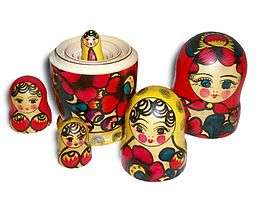Papakha
Papakha or, Azerbaijani: papaq; Adyghe: па1о, pa'o; Georgian: ფაფახი, p’ap’akhi, [pʰapʰaxi]; Chechen: холхазан куй, xolxazan kuy; Russian: папа́ха, papakha, IPA: [pɐˈpaxə]), also known as astrakhan peruk in English, is a wool hat worn by men throughout the Caucasus and also in uniformed regiments in the region and beyond. The word papakha is of Turkic language origin (papak). In Azerbaijani, papaq translates to hat. [1][2][3][4]
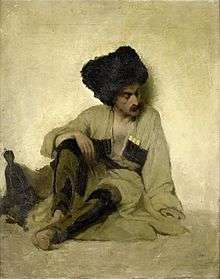
Styles
There are two different Caucasian papakhas. One, called a papaha, is a high fur hat, usually made of karakul sheep skin. The hat has the general appearance of a cylinder with one open end, and is set upon the head in such a way as to have the brim touch the temples. Some of them come with ear flaps which can be folded up when not in use. The other called a kubanka, which is similar to the papaha, except shorter and with no ear flaps.
Prevalence
Papaqs are very important to mountainous peoples’ of the Caucasus, where a man's hat is considered a very important part of his identity. In Georgia, papakhi are also mostly worn in mountainous regions of Pshavi, Khevi, Mtiuleti, and Tusheti. Papaq are also very common in Azerbaijan.[5][2] Papakhi are also donned by the Chechens, Dagestanians, and other Caucasian tribes. In 1855, after the campaigns in the Caucasus Mountains, the Papakha was introduced in the Russian army as an official part of the uniform for the Cossacks, and later for the rest of the cavalry.
Russian and Soviet army uniforms
Shortly after the Russian Revolution of 1917, papakhas were removed from the new Red Army uniform because of their association with the old Tsarist regime and the fact that many Cossack regiments of the Tsarist army fought against the Bolsheviks. During the Russian Civil War, many Bolshevik cavalrymen and officers (like Vasily Chapayev) wore papakhas or kubankas because many of them were cossacks and the hat had been part of the cavalryman's uniform.
Papakhas became part of the uniform again in 1935, but in 1941, were reserved exclusively for full colonels, generals and marshals, thus becoming a symbol of status and high rank. Much later, during Andrei Grechko's tenure as a Defence Minister, the Navy followed suit, introducing their own distinct version resembling a smallish "kubanka" with a visor, which was nicknamed "шапка с ручкой" ("the hat with a handle") by the troops.
In 1994, they were once again removed from military use. Allegedly this was by request of the wearers, who found the hat inefficient. (As the papakha is a relatively short hat that does not protect the ears well, it might be well suited to the mild climate of the Caucasus, but not to lower temperatures elsewhere. Also it is not very wind-proof.) The act of removing the papakhas was seen in some quarters as an attempt by the Boris Yeltsin regime to abandon earlier Soviet traditions and symbolically demonstrate the country's commitment to a new political course. In 2005 however, papakhas were reinstated.
Contemporary Papakha
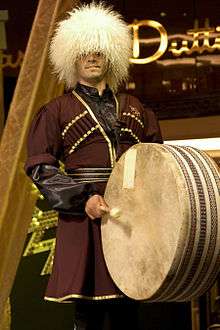
The Papakha's heritage comes from the Caucasus region, and is worn across the entire region, including Azerbaijan, Georgia, Armenia, Dagestan, and Chechnya, as well as Russia and the Ukraine.[6]
Gallery
 Two Persian peasants and two Persian officers gambling, between 1876 and 1933; the standing peasant is wearing a papakha. Brooklyn Museum
Two Persian peasants and two Persian officers gambling, between 1876 and 1933; the standing peasant is wearing a papakha. Brooklyn Museum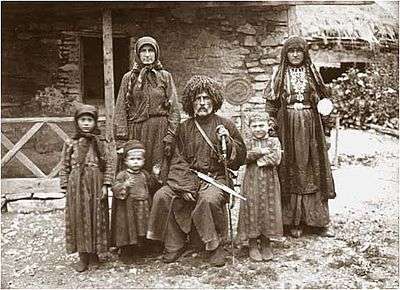 Vazha-Pshavela wearing Georgian papakha
Vazha-Pshavela wearing Georgian papakha Japonese wearing Turkmen Papakha
Japonese wearing Turkmen Papakha Meeting at the airport with Turkmen Papakha
Meeting at the airport with Turkmen Papakha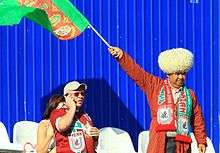 Turkmen fotball fan with Papakha
Turkmen fotball fan with Papakha
See also
- Karakul (hat)
- Khabib Nurmagomedov, MMA fighter who frequently wears a papakha
- Ushanka, Russian fur hat with "ear flaps"
- Busby
References
- "папаха - это... Что такое папаха?". Retrieved 9 August 2017.
- electricpulp.com. "CLOTHING xxi. Turkic and Kurdish clothing – Encyclopaedia Iranica". www.iranicaonline.org. Retrieved 9 August 2017.
- Rudevich, Alexéi (6 January 2015). "Head high in a papakha: The history of a hat that can never be removed". Retrieved 9 August 2017.
- "memim.com". memim.com. Archived from the original on 26 June 2015. Retrieved 9 August 2017.
- http://www.thelovelyplanet.net/traditional-dress-of-azerbaijan/9
- https://www.rbth.com/arts/2015/01/06/head_high_in_a_papakha_the_history_of_a_hat_that_can_never_be_removed_42153.html
External links


